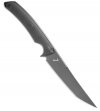Nathan the Machinist
KnifeMaker / Machinist / Evil Genius
Moderator
Knifemaker / Craftsman / Service Provider
- Joined
- Feb 13, 2007
- Messages
- 18,232
^ not very nice of you to talk behind Tommy's back like that. Plus, wait your turn grasshopper as I have asked Nathan 3 questions yet to be answered:
1- what in his esteemed and expert opinion constitutes a "weapon" so far as blades are concerned?
2- what are the differences, if any, between the planned production model BC and the 15-20 of the prototype BCs (although not labeled as so) existing in the wild?
3- Um! I forgot
1 - this question justifies a video at some point. A big part of any knife design is the grip and how it allows a knife to be used. A weapon will generally need to work in a reverse grip and designed for effective stabbing. So the grip is short enough you can get your thumb over the end and the finger guard, grip swells and thumb ramp will all align to a hand in this grip to prevent it from slipping in a hard stab. Also, when held in a saber grip the grip on a well tuned knife will cause the knife to point naturally along the arm and not jut off to one side. There are weight issues (you usually want a weapon to be light and nimble) that are at odds with the tip strength and the higher moment of inertia you'd want in a stabbing weapon. Historically edged weapons often had a weighted pommel which gave the knife some resistance to rotation so an attempt to block the blade doesn't result in the point being bumped too far from its target. There are compromises in a design but you'll often see some weight at the ends, unnecessary weight removed from the blade (with a fuller not with thin stock, because of strength requirements) and some additional meat to reinforce behind the point. As a general rule there are thrust, cut, and thrust/cut weapons with their own sets of requirements, but all of them when used in modern combat are no longer a "left hand weapon" but in the right hand, frequently in a reverse grip, and used while grappling. In contrast, a knife that is primarily a tool will see a grip that is designed to accommodate multiple working grips (rather than fighting grips) in order to reduce hot spots and hand fatigue, allow different kinds of precision cuts, and a blade geometry intended to reduce drag in materials harder than people. This really needs a video with illustrations.
2 - The differences from the prototype BC to the production BC will be refinements to the handle and some minor tweaks to the grind.
3 - damn you're old


